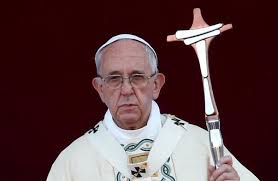
There is a qualitative difference between the faith of western Catholics after the turn of the 20th century and tradition-minded Catholics of all times and places. Modern Catholics are skeptical of the Church’s traditional teachings which place a restraint on unlimited personal pleasure or satisfaction, or which require subjection to a religious authority (or any authority). The differences between what modern Catholics “believe”, and what traditional Catholics believe are so numerous that it would appear that either the Catholic Church is comprised of only a small number of true believers or the number of Catholic doctrines that one must believe is so small that it doesn’t even include the existence of a physical hell. But I would argue instead, the test to apply today is not so much what a professing Catholic believes, but rather how he believes (which necessarily informs what he believes).
The modern Catholic approaches the teachings of the Church, like all things in the modern worldview, with an assumption that they must somehow “evolve.” He then attempts to “distinguish” difficult doctrines, as we say in the law. The doctrine is isolated, applied only to the people of its time, or limited to the facts that lead to its establishment. In this way, the traditional doctrine is questioned by the intellect and rejected by the will. The result is unbelief. Thinking in this mode appears to be common among many Catholics today, even those who consider themselves to be “conservative.”
Take, for example, the Church’s longstanding teaching against contraception (see quotes from the early church fathers condemning it here). A Catholic in the modernist mode, when presented with the Church teaching against contraception will likely not assent to it – most likely because it is either socially uncomfortable to do so or because he is violating the Church teaching with his own acts. He hears little to nothing against it from any priest or bishop, especially at mass. If he conducts his own research, it will be to find authors, even priests, who distinguish the early teachings of the Church as inconclusive or unenlightened and he will invariably come to the conclusion that it will only be a matter of time before the Church realizes she got it wrong and will change the doctrine like an errant Supreme Court opinion. And yet, he considers himself to be a good Catholic and receives communion weekly, if not daily.
But that one’s easy. The modernist is readily apparent who doubts the Church’s teaching on contraception. Let’s take a more difficult example and see how the modernist mode provides the “tools” to reject uncomfortable doctrines for even “conservative” Catholics.
The Church has always taught that in a marriage the husband is the head of the family. St. Paul put it pretty clearly in his letter to the Ephesians, “Wives, be subject to your husbands, as to the Lord. For the husband is the head of the wife as Christ is the head of the church…. Husbands, love your wives, as Christ loved the church and gave himself up for her….” We hear this quote in mass once per year, or every couple years for the new mass. But rarely at the new mass is there any reference to the Church’s doctrine on the matter, if the priest dares address it in his homily at all. And yet, not only did St. Paul see it as important enough to write down, Leo XIII in Arcanum divinae sapientiae (1880) repeated the doctrine in his encyclical against divorce. Similarly, Pius XI in Castii Canubii (1930) reiterated this Church teaching and explained, “This subjection, however, does not deny or take away the liberty which fully belongs to the woman both in view of her dignity as a human person, and in view of her most noble office as wife and mother and companion; nor does it bid her obey her husband’s every request if not in harmony with right reason or with the dignity due to wife … But it forbids that exaggerated liberty which cares not for the good of the family; it forbids that in this body which is the family, the heart be separated from the head to the great detriment of the whole body and the proximate danger of ruin. For if the man is the head, the woman is the heart, and as he occupies the chief place in ruling, so she may and ought to claim for herself the chief place in love.”
Catholics today, of every stripe, deny in word or in practice this clear but socially uncomfortable doctrine when confronted with it. Are you not tempted to dilute it? to distinguish it? or to ignore it? In your mind, do you relegate it to being merely an artifact of a bygone era? Have you begun preparing a mental list of so many exceptions that the doctrine would seem meaningless? Would you argue that the papal encyclicals referenced above are not binding? Are you expecting the Church to update this teaching like St. Pope John Paul II allowing girls to serve at the new mass? Are you a good Catholic if you answer “yes” to any of these direct questions? We could undertake the same exercise with respect to Church teaching on a variety of topics that push people’s buttons.
Contrast the modernist approach to Church doctrine with the approach of tradition-minded Catholics. When presented with a “hard saying” or restrictive doctrine that has been handed down through the ages, the traditionalist assents to it with his will in the first place as a defined doctrine. If his intellect seeks clarification on a point or two, he undertakes to find the clarification, with the assumption that it exists and will satisfy his intellectual curiosity. This is not blind submission, but reasoned assent.
Considering there appear to be only these two modes of belief among those who call themselves “Catholic” today, I would argue the defining mark of a Catholic Christian is not whether he can recite chapter and verse to support or defend a Church teaching. It is not even whether he knows all the Church teachings. It is, quite simply, which mode of belief he applies to Church teaching. The faithful Catholic assents with his will (and thereby his actions and his intentions) to all Church doctrines, no matter how socially or personally uncomfortable. He loves the Church, he sees her goodness and beauty through the ugliness of the age, he listens to his Mother. And he trusts her. How many Catholics believe like that today?
